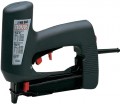Operation type
The actuation method provided in the design of the nail/stapler.
-
Contact. This option assumes that direct contact with the material being processed is necessary for operation. Usually, a movable working tip (“nose”) is used for this: until the tool is pressed against the material and the nose is not retracted to the stop, the mechanism will not work. This way of actuation has a positive effect on both efficiency and safety of work: tight contact ensures that the fastener will be hammered as reliably as possible, and the risk that the hammer will “shoot” with a staple or nail in the air is reduced to almost zero. However the need to press the tool tightly every time reduces the speed of work: although pressing takes a fraction of a second, however, on tens and even more hundreds of clogged fasteners, this moment becomes noticeable. On the other hand, many tools provide the ability to hold the trigger so that the stapler automatically fires each time the spout is pressed. But the unequivocal disadvantage of this option can be called the fact that the presence of a safety contact mechanism complicates and increases the cost of the tool.
-
Non -contact. Mechanisms that work regardless of whether the tool is pressed against the material or not. Other things being equal, the non-contact method of operation is faster than the contact one, because. does not require additional "body movements" du
...ring work. And the tool itself is lighter and cheaper. On the other hand, non-contact triggering requires increased care from the user: if handled carelessly, the tool can trigger at a certain distance from the surface of the material (which impairs clogging efficiency), or even “shoot” in an undesirable direction, which is fraught with material damage and even serious injury .Min. staple width
The smallest staple width that the stapler can handle.
The width of the bracket is, roughly speaking, the distance between its legs. Different situations and types of work require different sizes of staples, sometimes quite small. At the same time, staples that are too small will hang out in the store and will not be able to properly fit under the drummer, which is why modern staplers have a minimum size limit. You should pay special attention to it if you plan to work with brackets of small width.
Min. staple length
The smallest length of staples (see Fastener Type) that the stapler can work with.
The length in this case means the length of the leg — in other words, the depth to which the staple clogged "to the stop" penetrates into the material. Small staples do not require much power to drive, but the tool may not be designed for fasteners that are too short due to other parameters — for example, the design of the magazine. Therefore, for many models, this limitation is quite relevant, and in powerful professional models, the minimum length can be quite large — more than 20 mm.
Max. staple length
The largest length of staples (see Fastener Type) that the stapler can work with.
The length in this case means the length of the leg — in other words, the depth to which the staple clogged "to the stop" penetrates into the material. This means that working with staples of great length requires not only the appropriate design of the magazine and the feed mechanism — the stapler must also be quite powerful in order to provide the effort necessary for effective clogging. And this, in turn, affects the dimensions, weight and price of the tool. In fact, this means that it does not always make sense to specifically look for a model that can work with long staples — you need to evaluate the specifics of the intended work: often the best choice is a relatively “short”, but at the same time inexpensive and compact tool.
In general, a limit of 10 – 15 mm is typical for entry-level staplers, and in professional models this parameter can exceed 50 mm.
Min. nail length
The shortest length of nails (see Fastener Type) that the stapler can handle.
The shorter the fastener, with the same thickness, the less effort is required to drive it, but a nail that is too short simply cannot stand under impact normally. Therefore, for many instruments, this restriction is directly indicated. It is worth paying attention to it first of all if you plan to work with small short nails.
Max. nail length
The longest length of nails (see Fastener Type) that the stapler can handle.
With the same thickness, a longer nail requires not only the appropriate space in the magazine and feed mechanism, but also a higher impact energy — otherwise it simply will not work to hammer it “on the head”. This means that the maximum fastener length is directly related to the power and, accordingly, the overall level of the tool. Recall that a powerful professional tool has the appropriate dimensions and weight, moreover, it is often made pneumatic (for more details, see "Type"). Therefore, it makes sense to look for models that are compatible with long nails only if this is critical for the planned work.

